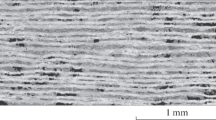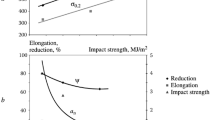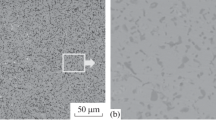Abstract
From a study of 63 systematic alloy modifications it was found that molybdenum, tungsten, and columbium, added individually or simultaneously, and increases in chromium cause major improvements in 1200°F rupture strengths of Cr-Ni-Co-Fe base alloys. Rupture strengths were a function of the effect of composition modifications on both the inherent creep resistance and the amount of deformation the alloy would tolerate before fracture.
Similar content being viewed by others
References
Symposium on Materials for Gas Turbines. A.S.T.M. STP No. 68 (1946).
J. W. Freeman, E. E. Reynolds, and A. E. White: Heat-Resistant Alloys for Use in Jet Propulsion Engines. Journal of the Aero Sciences (1947) 14, p. 693.
J. W. Freeman, E. E. Reynolds, D. N. Frey, and A. E. White: The Influence of Conditions of Heat Treatment and Hot-Cold Work on the Properties of Low-Carbon N-155 Alloy at Room Temperature and 1200°F. Proc. A.S.T.M. (1949) 49, p. 618.
N. J. Grant: The Effect of Composition and Structural Changes on the Rupture Properties of Certain Heat-Resistant Alloys at 1500°F. Trans. A.S.M. (1947) 39, p. 368.
N. J. Grant: The Stress-Rupture and Creep Properties of Heat-Resistant Gas Turbine Alloys. Trans. A.S.M. (1947) 39, p. 281.
N. J. Grant: The Cobalt-Chromium J Alloy at 1350°F to 1800°F. Trans. A.S.M. (1948) 40, p. 585.
E. Epremian: The Development of a Turbosuper-charger Bucket Alloy. Trans. A.S.M. (1947) 39, p. 261.
A. G. Guy: Nickel-Base Alloys for High-Temperature Applications. Trans. A.S.M. (1949) 41, p. 125.
O. E. Harder and J. T. Gow: An Emergency Heat-Resistant Alloy. Trans. A.S.M. (1944) 32, p. 408.
C. Sykes: Steels for Use at Elevated Temperatures. Journal Iron and Steel Inst. (1947) 156, p. 321.
T. Y. Wilson: High-Strength, High-Temperature Alloy S-816. Materials and Methods (1946) 24, p. 885.
J. B. Henry, Jr.: Characteristics of Three High-Temperature Alloys. Iron Age (June 12, 1947) 159, p. 58.
W. O. Binder: Alloys for High-Temperature Service. Iron Age (Nov. 7, 1946) 158, p. 46; (Nov. 14, 1946) 158, p. 92.
G. T. Harris and H. C. Child: Development of a High-Temperature Alloy for Gas-Turbine Rotor Blades. Symposium on High-Temperature Steels and Alloys for Gas Turbines. British Iron and Steel Inst. (1950) p. 67.
A. M. Borzdyka: The Influence of Alloying Elements on the High-Temperature Strength of Chromium-Nickel Austenite. Doklady Akad. Nauk SSSR (1949) 63, p. 265.
D. N. Frey, J. W. Freeman, and A. E. White: Fundamental Effects of Aging on Creep Properties of Solution-Treated Low-Carbon N-155 Alloy. Nat’l. Advis. Comm. for Aero. Technical Note No. 1940 (1949).
E. E. Reynolds, J. W. Freeman, and A. E. White: Investigation of Influence of Chemical Composition on Forged Modified Low-Carbon N-155 Alloys in Solution-Treated and Aged Condition as Related to Rupture Properties at 1200°F. Nat’l. Advis. Comm. for Aero. Technical Note No. 2449 (1951).
Author information
Authors and Affiliations
Additional information
Discussion on this paper, TP 3344E, may be sent, 2 copies, to AIME by Dec. 1, 1952. Manuscript, March 10, 1952. Philadelphia Meeting, October 1952.
Rights and permissions
About this article
Cite this article
Reynolds, E.E., Freeman, J.W. & White, A.E. Influence of Chemical Composition on the Rupture Properties at 1200°F of Wrought Cr-Ni-Co-Fe-Mo-W-Cb Alloys. JOM 4, 946–958 (1952). https://doi.org/10.1007/BF03397752
Published:
Issue Date:
DOI: https://doi.org/10.1007/BF03397752




